The L235 Flat Flyer Pleco (scientifically known as Pseudolithoxus anthrax) is a member of the Loricariidae family (plecos) that is somewhat new and rare in the aquarium hobby. In recent years they have become a very popular choice for community aquariums. Despite the popularity of this fish, we have not seen a good high quality guide on how to properly care for this fish. There is much accurate information shared online about this species that new aquarists might follow which may result in disastrous events in their aquarium.
These fish are hardy and can tolerate different environments, but it is important to create a healthy tank for these guys to thrive. This article will guide you through the essential information about Flat Flyer Pleco Care. We will also provide a bunch of other useful tips and tricks to make you an expert in caring for this fish.
Species Profile & Overview
Plecos are long-kept aquarium fish and the Flat Flyer Pleco ( L235 Pleco ) is one of the most beautiful fish in the Loricariidae family (plecos). Not only do they add beauty to your tank, but also add functionality. This makes them an ideal choice for most aquarium setups.
Often known as L235 Pleco, these fish are not as common in pet stores as other types of plecos. This makes them quite pricey compared to more regular types of plecos. They are known for their flat body which sets them apart from most plecos.
Unlike aquarium environments, in their natural habitat, these fish have very low visibility in the water. Water is warm and filled with organic matter that many small creatures will feed on. The Flat Flyer Pleco usually feeds on these microorganisms and any other available food sources. Like all catfish, They are hardy and can tolerate different water conditions.
Appearance:
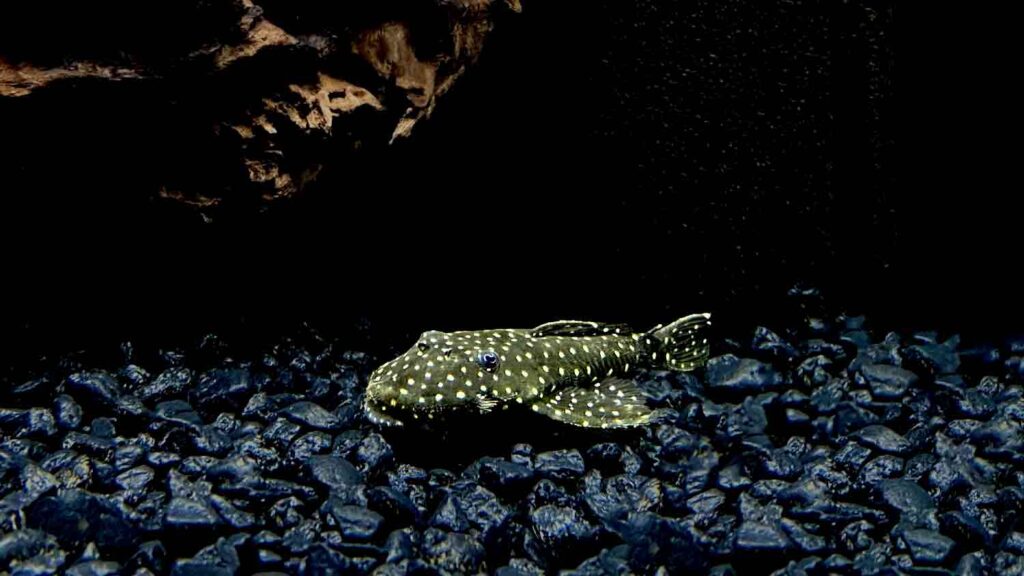
The Flat Flyer Pleco is a beautiful fish that will draw every viewer’s attention. The contrast between their background and foreground colors makes them look absolutely beautiful.
The Flat Flyer Pleco is a copy cut of the known pleco mold but is more flat. They have a thin and pushed down body where it gets wide in the head and narrows toward the tail. Same like all plecos, they have a bony back that protects them from other predators. Unlike their back, their belly is soft and has a thin skin. The eyes are on top of the head where they can have a wide view of their surroundings. Like most bottom-feeder fish, their mouth is downward under the head.
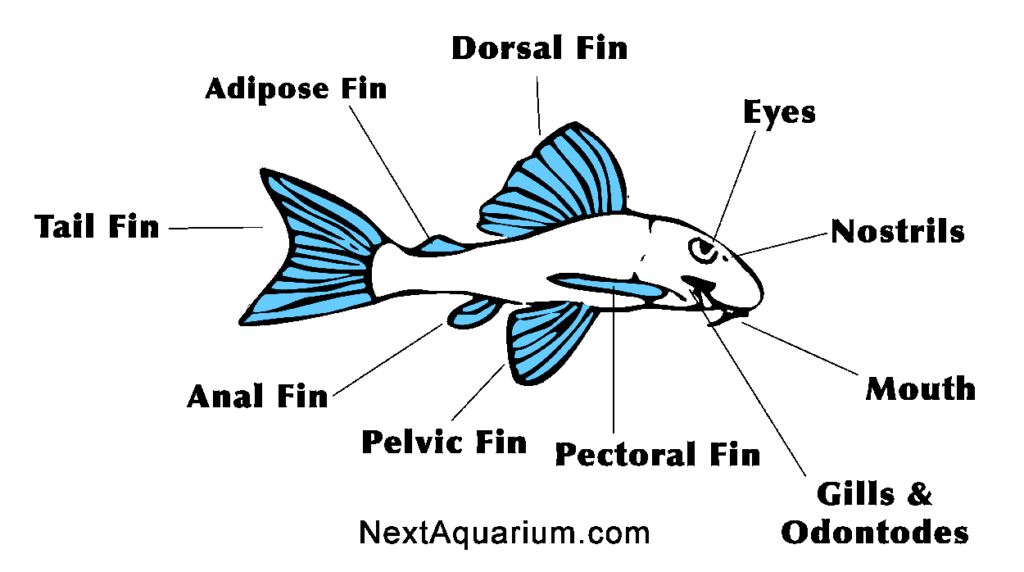
They have 8 fins in total, the dorsal fin and tail fin is the biggest fin on their body. Fins usually have the same patterns and color as the rest of the body but are semi-transparent.
This fish has a dark green background color that is decorated with lots of small white dots. These dots cover the entire back and are stretched on the head and fins. Belly has the same patterns in some specimens but the majority lack the dot patterns on their belly.
Adult Size
When fully grown, the average Flat Flyer Pleco size is around 5 inches in length. This makes them an ideal pleco for most medium and large aquarists that do not house super large or aggressive fish.
They are very slow-growing fish and will take years for them to reach their max size. However, when you provide proper care and diet, the l235 will grow faster.
Lifespan
The L235 Pleco lifespan is about 8-10 years in captivity. Under the right conditions, they will live even longer. However, they reach this age when they are not under stress and get pristine care throughout their lifetime.
Behavior and Temperament
Flat Flyer Pleco are relatively peaceful nocturnal fish and mostly active at night. However, this does not mean that they will not swim around in the daytime. When they feel safe, they will come out and scavenge for food no matter the time of the day.
L235 are known to get a bit territorial with other bottom-dweller fish. This is particularly true with males, when you house more males in a tank they will fight over caves and hiding spots.
Having more pleco caves and hiding spots will prevent aggression among males. You will need to add at least a pleco cave for each male that you have in the tank. When males get enough caves they will each pick a cave and will not fight with each other.

Flat Flyer Pleco Care
Flat Flyer Pleco care isn’t very hard and many believe that these fish are one of the easier Pleco species to keep. We recommend this species for hobbyists of different skill levels if they have an ideal tank for them.
That being said, this fish needs pristine water that matches its natural habitat. They will also need a rich diet that provides all the elements they need to thrive. You should always focus on maintaining ideal water parameters in the tank.
To provide your Flat Flyer Pleco with the best possible habitat, you should follow the suggestions below.
Tank Size
The minimum tank size for a single Flat Flyer Pleco is 50 gallons. Juveniles can live in smaller aquariums but you will have to upgrade once they grow. It is always best to have a larger tank right from the beginning.
If you are planning to keep more than one of the L235 Plecos then you should get even a bigger aquarium. These fish need a lot of bottom surface so the gallon that your tank can hold might not always be the best way to calculate how many plecos you can keep in your tank.
To give your Flat Flyer Pleco more floor space, if possible, choose a tank that has a wider base. Then, simply add a lot of slates and tiles to the tank to create even more floor space. Your plecos can swim over and under these slates and tiles to hide and take refuge.
Tank Setup:
Setting up the right habitat for Flat Flyer Pleco is very important. These fish are shy and easily get stressed, which makes them vulnerable to disease and might even cause death. While these fish aren’t too fussy, they still need to have a few items in the tank.
You will need to place several pleco caves in your tank so they can feel safe during the day. There are many different premade caves available in the market that are made specifically for plecos. Along with caves you will also need to place lots of rocks and driftwood in your tank to create even more shades and hiding spots. These caves and hiding spots will block the light and keep the pleco protected from other fish.
Because of their soft belly, these fish need a soft and fine substrate. The rivers these fish are coming from have fine sandy and muddy substrate. In an aquarium, sand is the best substrate for plecos, however, if you have plants in your tank then many planted substrates are also great options.
Having live plants in your tank will help you create a more balanced aquarium. Most plants will do fine with Flat Flyer Pleco so pick a few of your favorites and make your tank look astonishing.
Water Parameters:
Keeping your tank’s parameters stable is the key for Flat Flyer Pleco. Stable water parameters are crucially important to the health of this fish. In the wild, these fish have well-oxygenated warm waters that have very low TDS. This means you will also need to create a similar environment in your aquarium. Below are the range you can keep L235 Plecos in:
- Temperature: 75 – 82 Degrees Fahrenheit
- PH: 6.2 – 7.0
- TDS: 60 – 160 PPM
When you first bring your L235 Pleco home you will need to perform regular water tests to make sure water parameters are in favor of your pleco. After a few a week or two if you see no fluctuation in the tank then you will not need to perform as many tests as in the first week. We highly recommend having a TDS (Total Dissolved Solids) meter and changing the water every time the tank’s TDS crosses the recommended range.
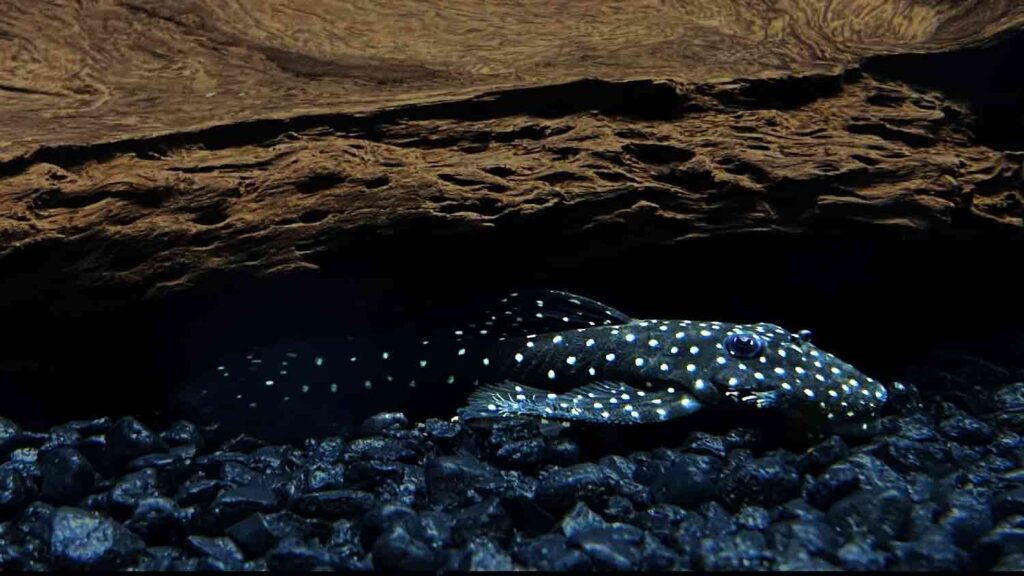
Lighting:
With the right tank setup, Flat Flyer Pleco does not have specific lighting needs and can adapt to any lighting conditions in the aquarium. So it’s best to choose your light according to the types of plants you are keeping in the tank.
Filter System:
Flat Flyer Pleco requires strong filtration, thus we recommend purchasing the most powerful filter available. Most people might argue that larger filters are overkill, but we believe it ‘s better to be safe than sorry! Larger filters will keep your water sparkling clear and can withstand ammonia surges far better than smaller filters.
Common Diseases and Prevention
These hardy fish are susceptible to the most common aquarium diseases. Aquariums are tiny ecosystems, this means parasites and diseases will easily and quickly transfer from fish to fish.
Most diseases are directly introduced to your tank by newly added fish, plants, or invertebrates. Poor maintenance will also cause bacterial or fungal infections. These are the main reasons aquarium fish get sick. In order to prevent them, you should never add fish or plants to your tank without properly quarantining them. Regular tank maintenance is also super important. Never let any uneaten food stay in the tank for long periods as it will start to rot and increase the risks of bacterial or fungal infection.
Diet and Feeding Requirements
Flat Flyer Pleco are omnivores and will eat a variety of different types of fish food. You will need to feed them a mix of different plant-based foods and occasionally feed them frozen or live high-protein foods. Make sure that your fish receive enough algae, plant matter, fresh vegetables, and other plant-based foods in their diet.
They do best on a low-protein plant based diet but should receive meaty foods as well. Frozen or live foods like bloodworms, brine shrimp, tubifex, daphnia, and other small creatures make a great protein source. All these food sources are available in pet stores and online.
Commercially produced fish foods like sinking pellets, shrimp wafers, and algae wafers are the ideal food to feed your pleco daily. A mix of these dry foods will nourish your fish with all the nutrition it needs. Plant-based pellets or fish flakes mixed with low amounts of high-protein foods are an ideal mixture to feed.
Make sure to feed your Flat Flyer Pleco at night. These fish are shy and passive so they will come out to feed when other fish are resting. You will need to mainly feed them with dry commercially made pleco foods. These fish will easily sink and have most of the elements your L235 Pleco needs in its diet. Occasional high protein live or frozen foods are also highly beneficial to the health of the fish. However, they should only receive high protein foods 2-3 times per week.
Breeding Flat Flyer Pleco
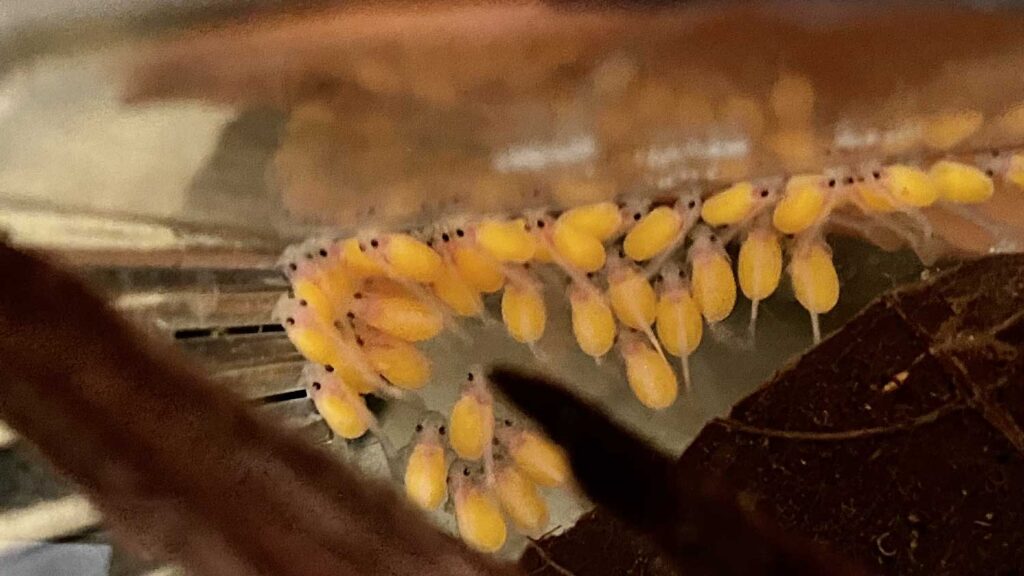
AllFlat Flyer Plecos that are available to hobbyists are wild caught and they have not yet been bred in captivity. This fish needs a very specific environment to breed and re-creating that in an aquarium is not easy. This and the fact that they are not super expensive is the reason why this fish has not yet bred in captivity.
If you still want to try your luck and try to breed them, here is what we know about breeding this family of fish:
In order to breed these fish, you will need your Flat Flyer Plecos to be mature and at least 4-5 years old. Once you confirm you have at least one male and one female in your breeding group, you can start to condition your fish for breeding.
These fish are found breeding in caves and crevices made in the fallen driftwoods and roxk. So you will need to provide them with a cave made of wood or ceramic at the right size so that the male can trap the female inside.
You will need to change your fish diet to a high protein live or frozen foods. High protein foods will encourage the female to develop eggs. When females develop eggs they become more round and that’s the time the male will start to fan the cave and wait for the female.
Water parameters and conditions of your tank have to change to what’s happening in the Orinoco River during the dry and rainy seasons. This is probably the hardest part to recreate.
Tank Mates
Flat Flyer Pleco can become aggressive when they are in breeding season or if they don’t have enough space in the tank. They tend to fight over territory or their favorite hiding spot. However, when the tank has the right design and decorations your L235 Pleco will live peacefully with other fish of roughly the same size or smaller.
Flat Flyer Pleco will mostly rest in its favorite hiding spot or will be busy scavenging for food. So they will not cause any issues to other fish in the tank. That said, you should avoid adding any aggressive fish that might go after your pleco. Larger fish might also try to eat your L235 Pleco so they can’t make good tank mates. Fish that need different water parameters should be avoided as well. Here are some of the fish we believe can make a great tank mate for your Flat Flyer Pleco:
- Molly Fish
- Dwarf Gourami
- Angelfish
- L333 Pleco
- L134 Pleco
- Discus
- German Blue Ram
- Zebrafish
- Tetras
- Hatchetfish
- Other Plecos
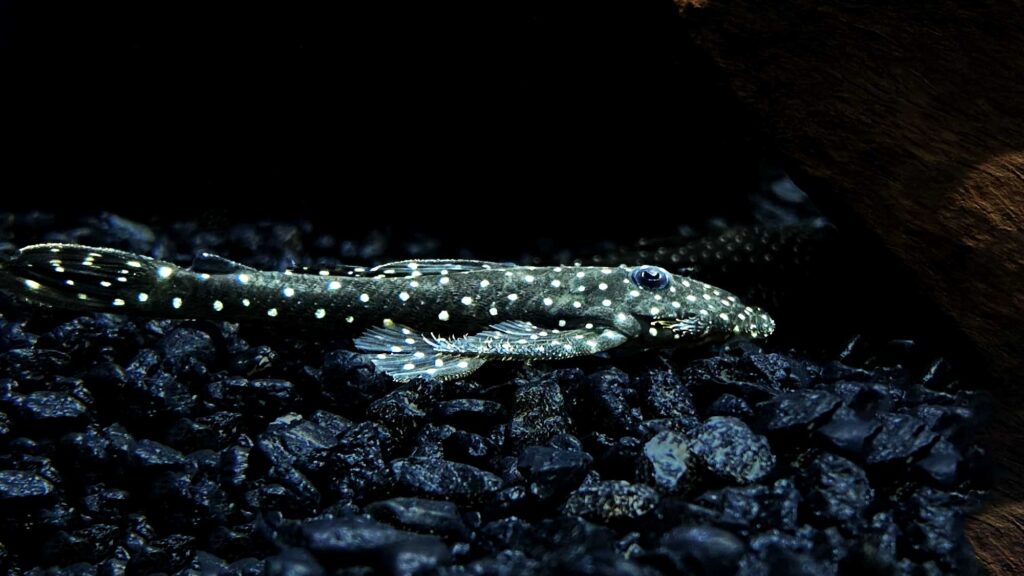
Conclusion
If you’re searching for a low-maintenance freshwater fish, the Flat Flyer Pleco can be a great choice. Because of its calm behavior and ease of maintenance, this species has become even more popular in recent years. If this fish is available for sale in your area and your tank parameters match what it needs then we highly recommend getting one.